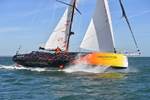Breton companies launch recyclable hydrofoil design project
Development and testing of recyclable, thermoplastic composite hydrofoil structures in Foil Infinity are expected to equip offshore racing yachts by 2030 and potentially even aircraft in the future.
A recyclable hydrofoil is tested on the laboratory boat of the MiniLab project. Source | Foil infinity
Originally reported by news agency , French companies Avel Robotics (Lorient), ComposiTIC (Ploemeur) and Mer Concept (Brittany) have launched the Foil Infinity project to design recyclable hydrofoils made of thermoplastic composites. The goal is to equip offshore racing yachts by 2030.
Each partner is bringing its composites expertise to the project. Avel Robotics is a manufacturer of composite parts for the nautical and aeronautical industries (read CW’s 2022 plant tour). ComposiTIC is a technical research institute from the Université Bretagne-Sud, specializing in the design of materials and automated processes based on robotized fiber placement technology and 3D printing. MerConcept is a French designer and builder of boats for ocean racing.
“The goal is to improve the environmental impact of hydrofoils by using thermoplastics, while maintaining the same performance as traditional foils,” explains Adrien Marchandise, co-founder and technical manager of Avel Robotics, “because the materials that make up the foil have a lifespan of 50 years. But the wing itself is obsolete after 5 years.” By using thermoplastics, recyclable and reusable materials, “we hope to reduce the carbon footprint of foils by 30%.”
A small wing (2.50 meters), made of 95% recycled or recyclable materials, is being tested as part of the collaborative MiniLab project that brings together Avel Robotics, ComposiTIC, IRMA and Victrex. Since 2023, this laboratory boat has been testing different eco-efficient materials and technologies in the field of ocean racing (learn more about the MiniLab ecosystem).
“After a year of research, we saw that we would be able to find outlets,” says Marchandise, who founded the MiniLab initiative to advance sustainability and reduce the sailing industry’s environmental impact. “To move on to the industrialization stage, we started building Foil Infinity in January 2024.”
The project is already financed at more than 50% by the region, for a total budget of more than €1 million. By 2030, partners hope to be able to equip the large Ultim trimarans and IMOCAs of the Vendée Globe.
The Foil Infinity project’s next goal is to continue optimizing the recycling method of these structures so they can be offered to aircraft manufacturers. “The planes of tomorrow will potentially be made of thermoplastics by 2030-2035,” projects Marchandise. “We hope to be able to accumulate recycling experience on real nautical parts and learn from it before the production of recyclable aircraft wings is launched.” Avel Robotics is noted to already work with aircraft manufacturers such as Airbus, ArianeGroup and Pilatus.
Related Content
-
Infinite Composites: Type V tanks for space, hydrogen, automotive and more
After a decade of proving its linerless, weight-saving composite tanks with NASA and more than 30 aerospace companies, this CryoSphere pioneer is scaling for growth in commercial space and sustainable transportation on Earth.
-
Al Seer Marine, Abu Dhabi Maritime unveil world’s largest 3D-printed boat
Holding the new Guinness World Record at 11.98 meters, the 3D-printed composite water taxi used a CEAD Flexbot to print two hulls in less than 12 days.
-
Dawn Aerospace reusable rocket-powered aircraft flies twice in one day
Eighth and ninth flights of composites-intensive Mk-II Aurora reach an altitude of 63,000 feet, demonstrates same-day reusability capability for rocket-powered systems.






